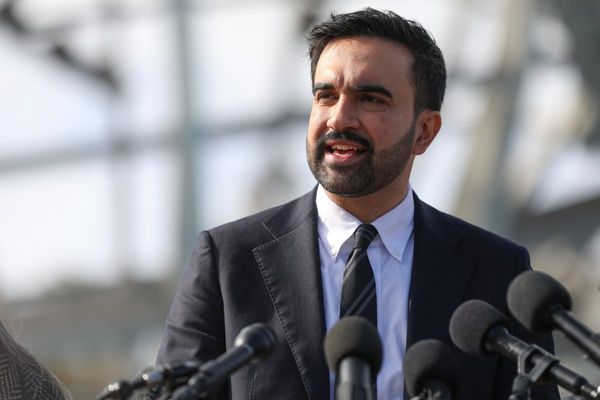Before I really dig into this, I want to state something very directly. On the whole, I like EV motorcycles. I've ridden quite a few, and I've found something to enjoy about every single one.
Are they perfect? No, but neither are gas-powered motorcycles. In fact, one thing they have in common is that I usually find things to both enjoy and to be annoyed by, to varying degrees, about both genres of motorcycle. That's really just life, isn't it? Finding what you like most, and what offers the levels of compromises you can personally live with.
But while the hopeful part of me very much wants to see a utopian future where we're all able to zoom about on whatever motorcycles we like, powered by whatever means we deem appropriate for our purposes at the time, the practical part of me is also not blind to problems, both evident and potential.
So while it's disappointing that the US Department of Transportation suspended funding to the National Electric Vehicle Infrastructure program in February, it's also not surprising unless you haven't been paying any attention. I'm writing this in the middle of May, which means it's been about three months (give or take) since this suspension happened. Sorry, but that's also not enough time to fully account for the damage that's accrued over the past handful of years.
Why do I bring this timing up? Because during the Harley-Davidson annual shareholders' meeting in May, the brand's CEO and LiveWire Group chairman Jochen Zeitz blamed a lack of charging infrastructure, and slower-than-expected EV adoption, for LiveWire's ongoing woes.
And while those things certainly haven't helped, they're far from the company's only problems. I say that both as someone who appreciates EV motorcycles for what they are and where they could potentially go, as well as someone who's been keeping an eye on LiveWire sales since the brand has existed.
As such, he misses a lot of the nuance of the situation. So, let's get into it.
1. Cost

When Harley-Davidson launched its very first LiveWire EV motorcycle, most of those who rode it thought it was a lot of fun. As I've said before and will no doubt say again, there's something about instantly available top torque that puts a stupid grin on your face, at any speed. Add in those light speeder noises you can only get from EVs, and there's definitely a strong appeal for some riders.
Only (or primary) trouble was, the original Harley-Davidson LiveWire was priced far too high for the youths that Harley was hoping to rope into the fold with its slick new product.
In case you haven't noticed, successive generations of kids since Gen X haven't exactly been all right, financially speaking. Sure, there are trust fund kids, but those are outliers, and aren't how most of us live our lives. Instead, we've grown up in times of massive economic uncertainty, recessions, housing crises, ballooning student debt crises, and more; often well before we could begin to hit all those pesky adult milestones that cost untold (and quickly multiplying) amounts of cash.
There's no amount of forgoing a latte or an avocado toast that can make up for all that, nor conveniently add up to spare funds for a nearly $30,000 EV motorcycle.
In case you've forgotten, the original MSRP of the Harley-Davidson LiveWire was $29,799 at its debut just five years ago. Adjusted for inflation, the US Bureau of Labor Statistics Inflation Calculator tells me that's equivalent to $37,055.99 in April 2025 money. Woof.
I don't know about you, but I certainly didn't have a spare $30K lying around for a new motorcycle in 2020, and I definitely don't have a spare $38K lying around for a new motorcycle in 2025. And while I'm sure that someone does, I'm also reasonably sure they're a) not the youths that Harley was hoping to reel in, and b) since they're likely older, they're probably less likely to want to buy an EV motorcycle in the first place. An EV car, maybe; but an EV motorcycle? That's a big (and distinctly different) ask.
In fact, if we're talking about comparative EV car pricing in 2025, it's probably worth noting that the MSRP of a brand new 2025 Nissan Leaf starts at $28,140, or about $5K more than a new LiveWire ONE. Want a 2025 Chevrolet Equinox EV instead? That starts at an MSRP of $33,600, which is still less than what the OG price of the Harley-Davidson LiveWire from 2020 would cost today if adjusted for inflation.
Now, to be fair, Harley did realize that its initial LiveWire pricing was a problem. That's why, when it spun LiveWire off into its own company, it also dropped the price on what was essentially a refined version of the OG LiveWire by about $10,000. While an MSRP closer to $20,000 was certainly a lot more reasonable than $30,000, there are still an awful lot of other bikes you could buy for that money, including top-of-the-line options from the EV motorcycle granddaddy in the US, Zero.
Fast-forward closer to the present, and LiveWire's more affordable S2 range, and they're still all at least $16K. The LiveWire ONE is now back up to $23K at the time of writing, as well.
As we collectively totter on the brink of a will-we, won't-we global recession in May, a lot of people are being very cautious about how we spend our money right now. That's just a fact.
2. Availability, Consistency, and Uncertainty About the Future

When Harley-Davidson first launched the LiveWire EV project, the initial plan was for its EV line to be sold in existing Harley dealerships. There were several problems with this that are easy to identify in hindsight, of course, but that also probably shouldn't have been very difficult to predict if anyone had spent much time thinking about the rollout ahead of time.
For one thing, when people visit a Harley-Davidson dealership, they do so because they want to check out the bikes that Harley is known for. McDonald's, Chipotle, and Starbucks are all massively popular chains, but you don't go to Starbucks and ask for a quarter pounder with cheese, you know?
Again, once Harley realized that this placement was a problem, it re-evaluated and reconsidered how it wanted to position LiveWire as it spun the brand off into its own entity. Slowly, it began to establish dedicated LiveWire showrooms, beginning in California and steadily expanding to locations around the US. Eventually, LiveWire also expanded to Europe, where both governmental and public sentiment toward EVs is much more positive, and continues to expand more rapidly.
But LiveWire didn't do this until three entire years into its existence, and again, pricing probably isn't helping matters any.
Then, let's say you do hop on board with LiveWire, and you plunk down your cold, hard cash (or financing; however you roll) to bring home your LiveWire ONE or chosen S2 variant. LiveWire has the might of Harley-Davidson behind it, sort of, so it might seem to be on more solid ground in terms of "will it still be around to service my bike in 5 years" than most startups. That, I'll grant you.
But if you've been around the motorcycle industry for a few minutes, you already know that Harley has a certain history with non-Harley motorcycle projects it's taken under its wing. MV Agusta. Alta. Buell.
3. Harley's "Let's Have Our Cake And Eat It, Too" LiveWire Approach

What do I mean by this? No matter how you feel about Harley-Davidson, there's no denying that it's a brand with massive worldwide recognition. To reach similar levels of brand recognition in far-flung places, you usually need to be in a Mickey Mouse or maybe a Mario costume. Even people who've never ridden a motorcycle and may never ride a motorcycle know what Harley-Davidson is.
But longtime Harley fans mostly like what they like, and they know what they like. While there are likely some exceptions who might be interested in an EV produced by Harley, they're decidedly in the minority. No group is a monolith, so there are always outliers. But the vast majority just want their Road Glide or Fat Boy or are happy to buy and customize an old Sportster, please and thank you.
At the same time, if you're the type of younger rider who has a chip on your shoulder about non-riders hastily lumping all motorcycles into the nebulous categories of "Harleys" (meaning all cruisers, Harley or otherwise) and "crotch rockets" (meaning everything else, whether it's a sportbike or not), then it's true that you might be more open to the concept of an EV motorcycle.
But will you want one made by Harley? That's a more difficult question. Maybe, but also maybe not, depending on how you feel about whatever mental baggage you might associate with the image of Harley-Davidson that decades of popular culture only continues to reinforce. If Sons of Anarchy just totally made you cringe, then probably not.
Again, that's another part of why Harley spun LiveWire off into its own brand. But by that time, was the damage already done?
4. Charging Strategy/Lack of Charging Infrastructure

The original Harley-Davidson LiveWire and the subsequent LiveWire ONE had one serious advantage over most of their premium EV motorcycle competition: DC fast charging capability. See, Zero Motorcycles has long held that Level 2 charging makes the most sense for its bikes, because then riders can more easily charge both at home, and at L2 chargers in the areas they frequent.
As a very extreme example, if you've been following motovlogger and round-the-world traveler Marc Travels on his global journey on a Zero SR/F, you've seen that he's managed to make it work just about everywhere he goes with the help of the adapters he carries in his luggage. But he's the exception, not the rule.
As part of its attempt to rein in costs and offer more affordable bikes to its customers, LiveWire's S2 models also use Level 2 charging. This results in lower MSRPs, but it also has implications for how, when, where, and how fast riders can charge their bikes. While I haven't ridden a LiveWire S2 in Chicago yet, I can tell you from my experiences on another Zero SR/F that if you're in the city itself, Level 2 charging is plentiful.
But if you start to go beyond stop-and-go commuting and try to have more spirited, fun rides with your EV motorcycle that uses Level 2 charging, sooner or later (and probably sooner, let's be honest), you're going to need to recharge while you're out. Which is where range anxiety and/or the need to sit in place for a couple of hours if you want a full charge come into play.
If you were planning to stop for a couple of hours for lunch, that's fine. But if you just wanted to get a quick bite and then get back on the road to munch those miles and really thrash those curves, it's a major problem.
It's not, as I said, only a LiveWire problem, either. Rather, it's a case where, if you're trying to do more than just commute on a motorcycle, the combination of battery and charging technology just isn't where it needs to be to make it both practical and reasonably priced at the same time. The Zero SR/F I was happily riding for around a year was great fun to ride spiritedly, and it performed well. But at the same time, I had to be very strategic about how I rode it, as well as when I stopped to top it up, so I knew that I'd get home with no issues.
Even though I live and primarily ride in one of the most heavily populated metropolitan areas of the country, the further you get away from the city limits of Chicago (and just so we're clear, further away is where the fun roads are), the fewer and further between those Level 2 EV charging stations are. And that's to say nothing of the utter disaster that is needing to have an app for every EV charging station ecosystem instead of simply paying with your credit or debit card, like you do when you put gasoline in your ICE bike.
Who has the time or patience? EV charging infrastructure is absolutely a significant problem for LiveWire; it's just that it's not the only one, and it's silly to pretend that it is.
5. LiveWire's Quarterly Sales Figures Have Never Been Great
A lot of publications have posted headlines noting the 33 total LiveWire motorcycles that the company managed to sell during Q1 of 2025. But the fact is, this isn't even the single worst quarter the company has had in terms of sales (though, to be fair, it is currently tied with another previous quarter as having the worst units sold number since LiveWire started issuing separate financial reports).
To give credit where it's due, LiveWire did lose somewhat less money than it's reported in previous financial reports, so that has to count for something.
But anyway, here are those quarterly LiveWire sales figures for the past couple of years. Hover over any of the quarterly figures to see the total number for that quarter pop up on screen.
Now, since LiveWire was spun off into its own company, the StaCyc balance bike company (you know, for kids) has been grouped together with LiveWire for financial reporting purposes. However, until Q2 of 2024, StaCyc's numbers of units sold were not reported separately from LiveWire's; only revenues, profits, and other monetary figures were. Hence, the somewhat strange bar graph you see above.
As you can see, LiveWire's single best quarter so far, in terms of number of units sold, was Q4 of 2023. For that quarter, it recorded a total of 514 motorcycles sold, which the financial report of that time credits to the introduction of the S2 Del Mar. While LiveWire obviously hoped that the introduction of the first S2 model would signal an upswing in motorcycle sales, that has so far not materialized at the time of writing.
In Q2 of 2023, LiveWire also sold a dismal 33 total motorcycles. Will Q2 of 2025 be better? Unclear.
6. The Competition

Until it entered liquidation earlier this year, Energica was one of three premium EV motorcycle manufacturers scrapping for the same slice of riders with LiveWire and Zero, at least in the US.
However, toward the end of 2024, British EV motorcycle maker Maeving expanded from Britain to the US, and its stylish RM1S offers similar specs (at least, on paper) to the LiveWire S2 Del Mar, starting at a much more approachable $9,995. More recently, its limited-edition, head-turning Blackout RM1S came on the scene for $11,495, which is still less cash than any LiveWire S2 bike currently on the market.
Sure, there are several other EV scooters and motorcycles on the market (think NIU, Stark, Vespa Elettrica, and more), but they don't really compete head-to-head with LiveWire. And if the timeline stays true to the company's intentions, LiveWire will also have to compete with the Royal Enfield Flying Flea in 2026. Given how things have been going recently for the two companies as compared to one another, I'm pretty sure I know who my money's on.







